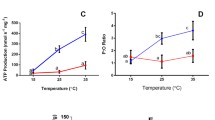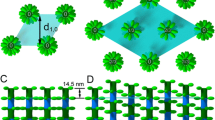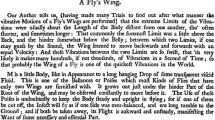Abstract
This report describes the isolation procedure and properties of tightly coupled flight muscle mitochondria of the bumblebee Bombus terrestris (L.). The highest respiratory control index was observed upon oxidation of pyruvate, whereas the highest respiration rates were registered upon oxidation of a combination of the following substrates: pyruvate + malate, pyruvate + proline, or pyruvate + glutamate. The respiration rates upon oxidation of malate, glutamate, glutamate + malate, or succinate were very low. At variance with flight muscle mitochondria of a number of other insects reported earlier, B. terrestris mitochondria did not show high rates of respiration supported by oxidation of proline. The maximal respiration rates were observed upon oxidation of α-glycerophosphate. Bumblebee mitochondria are capable of maintaining high membrane potential in the absence of added respiratory substrates, which was completely dissipated by the addition of rotenone, suggesting high amount of intramitochondrial NAD-linked oxidative substrates. Pyruvate and α-glycerophosphate appear to be the optimal oxidative substrates for maintaining the high rates of oxidative metabolism of the bumblebee mitochondria.
Similar content being viewed by others
Abbreviations
- cAtr:
-
carboxyatractylate
- DCPIP:
-
2,6-dichlorophenolindophenol
- 2,4-DNP:
-
2,4-dinitrophenol
- SDH:
-
succinate dehydrogenase
References
Banda, H. J., and Paxton, R. J. (1991) Acta Horticulturae, 228, 194–198.
Kevan, P. G., Straver, W. A., Offer, M., and Laverty, T. M. (1991) Proc. Entomol. Soc. Ontario, 122, 15–19.
Morandin, L. A., Laverty, T. M., and Kevan, P. G. (2001) J. Econom. Entomol., 94, 462–467.
Whittington, R., and Winston, M. L. (2004) J. Econom. Entomol., 97, 1384–1389.
Velthuis, H. H. W., and Van Doorn, A. (2006) Apidologie, 37, 421–451.
Cameron, S. A., Lozier, J. D., Strange, J. P., Koch, J. B., Cordes, N., Solter, L. F., and Griswold, T. L. (2001) Proc. Natl. Acad. Sci. USA, 108, 662–667.
Gill, R. J., Ramos-Rodriguez, O., and Raine, N. E. (2012) Nature, 491, 105–108.
Akerman, K. E., and Wikstrom, M. K. (1976) FEBS Lett., 68, 191–197.
Figueira, T. R., Melo, D. R., Vercesi, A. E., and Castilho, R. F. (2012) Methods Mol. Biol., 810, 103–117.
Zanotti, A., and Azzone, G. F. (1980) Arch. Biochem. Biophys., 201, 255–265.
Hatefi, Y., and Stiggal, D. L. (1978) Methods Enzymol., 53, 21–27.
Bergh, S. G. V. d. (1967) Methods Enzymol., 10, 117–122.
Palmieri, F. (2004) Pflugers Arch., 447, 689–709.
Haitina, T., Lindblom, J., Renstrom, T., and Fredriksson, R. (2006) Genomics, 88, 779–790.
Van den Bergh, S., and Slater, E. C. (1962) Biochem. J., 82, 362–371.
Servet, C., Ghelis, T., Richard, L., Zilberstein, A., and Savoure, A. (2012) Front. Biosci., 17, 607–620.
Bursell, E. (1975) Comp. Biochem. Physiol. B., 52, 235–238.
Lehmann, S., Funck, D., Szabados, L., and Rentsch, D. (2010) Amino Acids, 39, 949–962.
Sacktor, B. (1976) Biochem. Soc. Symp., 41, 111–131.
Bulos, B. A., Thomas, B. J., Shukla, S. P., and Sacktor, B. (1984) Arch. Biochem. Biophys., 234, 382–393.
Bertsch, A. (1984) Oecologia (Berlin), 62, 325–336.
Surhot, B., Greive, H., Hommel, C., and Bertsch, A. (1988) J. Comp. Physiol., 158, 263–269.
Author information
Authors and Affiliations
Corresponding author
Additional information
Published in Russian in Biokhimiya, 2013, Vol. 78, No. 8, pp. 1158–1164.
Rights and permissions
About this article
Cite this article
Syromyatnikov, M.Y., Lopatin, A.V., Starkov, A.A. et al. Isolation and properties of flight muscle mitochondria of the bumblebee Bombus terrestris (L.). Biochemistry Moscow 78, 909–914 (2013). https://doi.org/10.1134/S0006297913080075
Received:
Revised:
Published:
Issue Date:
DOI: https://doi.org/10.1134/S0006297913080075




